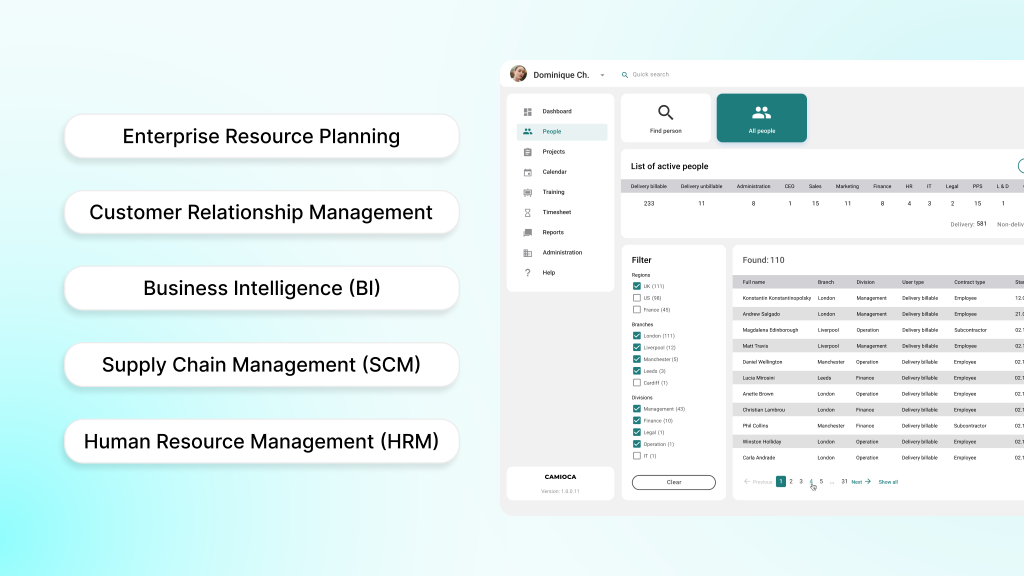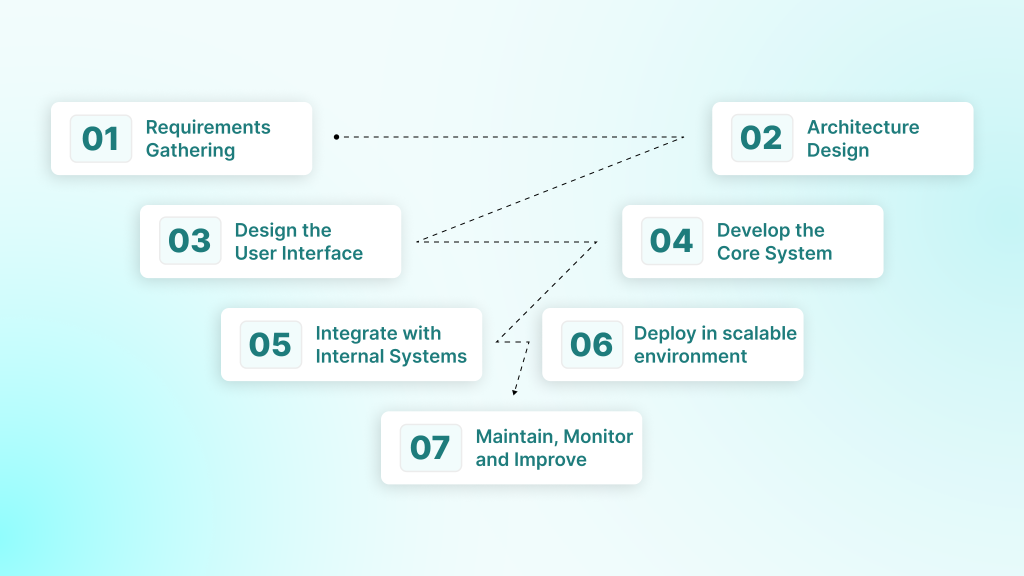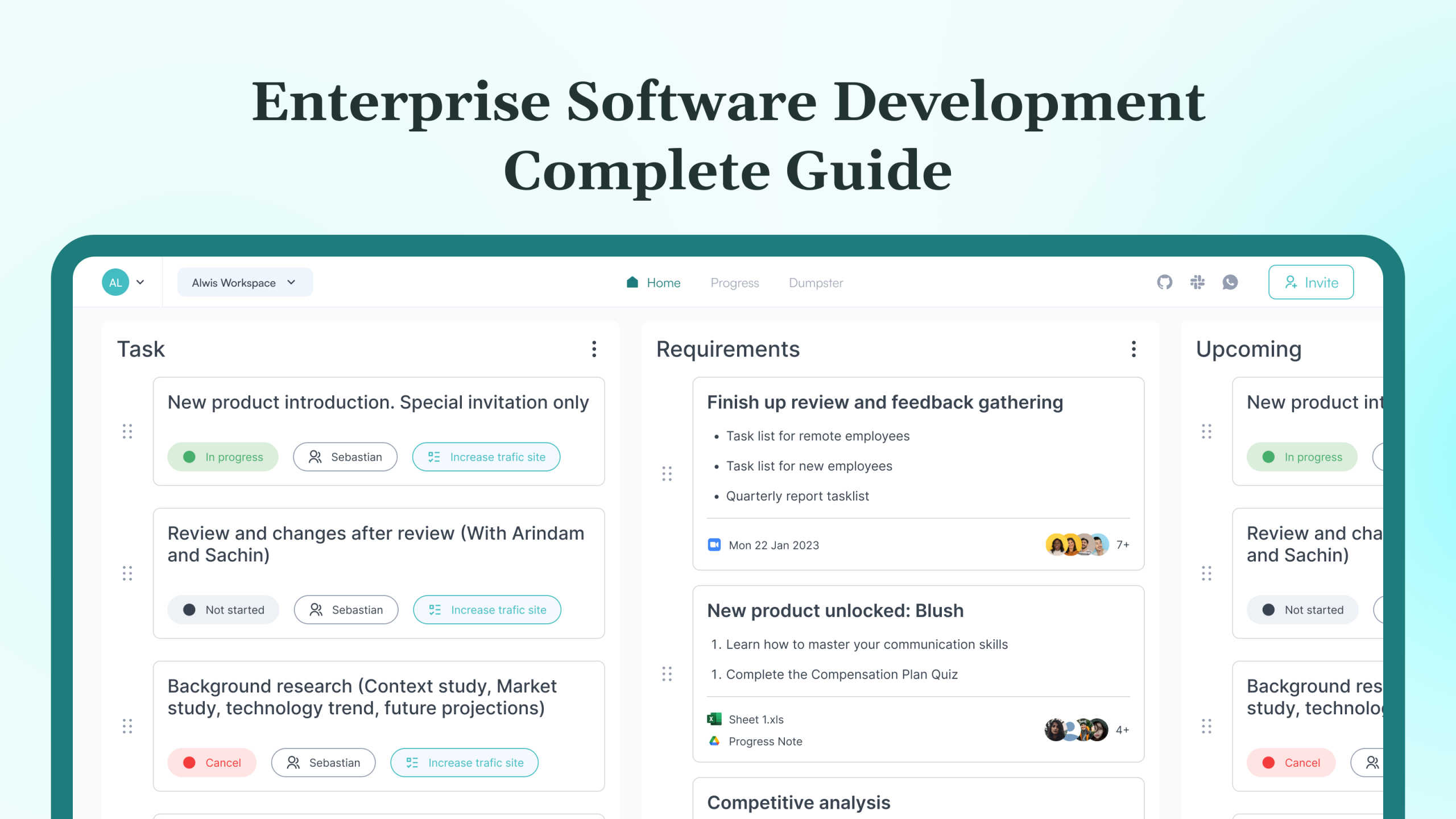Many large companies deal with disconnected tools, slow workflows, and outdated systems. These issues cause delays, limit visibility, and make it harder to adapt to new demands.
Enterprise software development fixes this by creating systems tailored to real business needs. Instead of adjusting to rigid, off-the-shelf tools, teams get software that matches their work style. These solutions scale, protect data, and facilitate seamless connections across departments.
This guide provides an overview of what enterprise software development entails. It explains the core technologies behind it, how to build it effectively, and why more companies now choose dedicated teams to deliver better results.
Key Takeaways
- Enterprise software replaces scattered tools with systems that fit real business needs. These systems scale with the company’s growth.
- A strong tech stack includes Java or Python, cloud services, secure APIs, and tools for testing, automation, and monitoring.
- To build these systems, teams need clear goals, strong architecture, smooth integration, and testing at every step.
- Common problems include vague scope, slow integration, low user adoption, and rising tech debt. Early planning and a transparent process help avoid them.
- Skilled teams build faster, design better systems, and deliver software that lasts.
What is Enterprise Software Development?
Enterprise software development builds core systems that support daily business operations and processes. These systems support key functions in finance, HR, logistics, customer service, procurement, and other areas.
They handle large teams, complex workflows, and sensitive data. The goal is to ensure stability, speed, and security.
Each system must scale with growth, integrate with existing tools, and comply with strict security and compliance requirements. A single failure can have a profound impact on the entire business.
To avoid this, teams need a clear understanding of business logic, data flow, process steps, and system limitations. The software must align with the business’s operations and evolve accordingly.
But enterprise software is not a single product. It spans across departments and functions, each with its challenges and requirements. Before building or investing in any system, it’s essential to understand the main categories that shape enterprise operations.
Types of Enterprise Software Development

Enterprise systems are built with specific goals. Some are designed to manage internal operations, while others are designed to improve customer relationships or supply chain coordination. These are the most common types found in large organizations:
Enterprise Resource Planning (ERP)
ERP systems consolidate essential business functions, including finance, HR, procurement, and operations, into a single central platform. They help teams:
- Unify organizational data.
- Automate repetitive, manual tasks.
- Improve overall efficiency and visibility.
Customer Relationship Management (CRM)
CRM software enables sales, marketing, and support teams to manage client interactions effectively. It allows businesses to:
- Track leads, contacts, and communication history.
- Build stronger relationships through data.
- Forecast sales and identify new opportunities.
Business Intelligence (BI)
BI tools turn large volumes of data into visual dashboards and reports. These systems are used to:
- Monitor performance across departments.
- Identify trends and risks.
- Support faster, evidence-based decisions.
Supply Chain Management (SCM)
SCM software supports logistics, inventory, and supplier coordination. With real-time tracking and reporting, teams can:
- Oversee production and delivery.
- Track suppliers and shipments.
- Optimize forecasting and stock levels.
Human Resource Management (HRM)
HRM systems help companies handle everything from recruitment to payroll. Key functions include:
- Streamlining hiring and onboarding.
- Managing employee records and leave.
- Driving engagement and performance tracking.
What are the Technologies Used in Enterprise Software Development
Enterprise software must scale, integrate with legacy systems, remain secure, and adapt to constant change. The technologies you choose form the foundation for building enterprise software that is scalable, secure, and ready for long-term growth. Here is how they contribute to building and maintaining reliable enterprise systems.
Programming Languages and Frameworks
- Java and C# offer strict typing, multithreading, and stable performance. They work well for long-term backend development in large systems.
- Python allows quick prototyping and automation. It also integrates well with analytics and machine learning features.
- JavaScript frameworks like React and Angular help build interactive, modular frontends. These connect smoothly with enterprise backends and APIs.
- Spring Boot, .NET, and Django give developers ready-made modules and a structured setup. This speeds up development and lowers the chance of errors.
Cloud Infrastructure and Deployment Platforms
- AWS, Microsoft Azure, and Google Cloud provide scalable hosting, strong security, and built-in services. They reduce the load on internal teams and help support users across locations.
- Infrastructure-as-Code tools (Terraform, CloudFormation) let you write and automate infrastructure setup. This saves time and ensures consistent deployments across every environment.
Data Management and Storage
- PostgreSQL, MySQL, and Microsoft SQL Server manage structured data and ensure accuracy. They are ideal for financial systems, HR tools, and logistics platforms where data integrity matters.
- MongoDB and Redis handle flexible data models and fast processing. They work well for caching, quick lookups, and handling unstructured or high-speed data.
- Snowflake and BigQuery support large-scale data analysis. Teams use them to find insights in operational data and build dashboards or business reports.
Integration and Communication
- RESTful APIs enable different systems to communicate with each other in a standardized manner. They help connect departments and external vendors by making data sharing easier.
- GraphQL gives clients more control over the data they receive. It works well when apps need to pull data from multiple services and require flexibility in accessing it.
- Kafka and RabbitMQ handle real-time messaging and event processing. They support fast data flow and help different parts of a system work independently.
Containers and Orchestration
- Docker ensures that applications run consistently across development, staging, and production by packaging code and dependencies together.
- Kubernetes automates scaling, fault tolerance, and service coordination across multiple containers, making it vital for managing distributed workloads in modern enterprise environments.
Continuous Delivery and Automation
- CI/CD tools, such as GitLab CI, GitHub Actions, and Jenkins, automate testing, builds, and deployments. These reduce human error and ensure the fast and safe release of new features.
- Automated pipelines also help enforce coding standards, run security checks, and ensure traceability, which is necessary for meeting audit requirements in regulated industries.
Security and Access Control
- OAuth 2.0, SAML, and OpenID Connect authenticate users and services securely. They are often used in systems that involve third-party tools or multiple user groups.
- Encryption protocols protect data while it is stored and during transfer. This is particularly important when handling sensitive information, such as customer records, financial details, or medical data.
- Static code analyzers, such as SonarQube and Snyk, identify security issues before deployment. They help reduce compliance risks and keep the software safe and reliable.
How to Build Enterprise Software: Key Steps

Enterprise software requires structured execution from discovery to deployment. Each step builds on the last, aligning business objectives with technical design to produce scalable, secure, and effective systems.
Step 1: Requirements Gathering and Analysis
Enterprise software development begins with the structured gathering of requirements. This includes collecting inputs from multiple departments, aligning business goals, and defining both functional and non-functional needs. At this scale, clarity is crucial to prevent scope drift and unmet expectations.
Workflows, compliance constraints, system integrations, and user roles must be thoroughly mapped. Teams document technical dependencies, performance expectations, and approval processes in a formal specification. This sets the foundation for system design and delivery planning.
Step 2: System Architecture Design
Architectural planning in enterprise projects focuses on scalability, fault tolerance, and integration readiness. The system must support high data volumes, concurrent users, and secure communication across internal and external systems.
Architects define service boundaries, API layers, and database models based on current and projected usage. Security, compliance, and disaster recovery planning are addressed during this phase. Well-defined architecture minimizes future refactoring, reduces infrastructure risks, and supports long-term maintainability.
Step 3: Design the User Interface and Experience
Designing enterprise software interfaces starts with mapping real user roles, workflows, and system permissions. Collect input from actual users in different departments to identify what tasks matter most and where friction exists in current tools.
Use wireframes and interactive prototypes to validate design direction before development begins. Prioritize clarity over visual effects. Maintain accessibility standards and responsive layouts for teams using the system across different devices and locations. At this scale, design choices have a direct impact on training time and adoption rates.
Step 4: Develop the Core System and Features
Begin development using frameworks that support modular, scalable architectures. Set up a clean codebase with separate layers for business logic, data access, and user interface. Use version control tools like Git with branching strategies that support parallel development and CI/CD.
Apply secure coding practices from day one. Implement logging, error tracking, and user role validation early, not as post-launch patches. Follow sprint cycles with working releases, and track velocity against your original estimates. Enterprise codebases often span multiple teams, so it is essential to enforce code standards and peer review processes to maintain long-term quality.
Step 5: Integrate with Internal Systems and Run Full Testing
Plan integration with legacy systems, data warehouses, or third-party platforms early in the development lifecycle. Define API contracts, data formats, and authentication protocols up front to avoid misalignment later.
Set up automated test coverage for unit, integration, and system-level tests. Simulate real-world conditions through load testing to ensure system stability under expected usage. Run vulnerability scans and compliance checks before deployment. At an enterprise scale, skipping or delaying testing increases technical debt and risks future downtime.
Step 6: Deploy in a Controlled, Scalable Environment
Before deployment, set up production-ready infrastructure with failover, backups, and real-time monitoring in place. Utilize cloud platforms like AWS or Azure for automated scaling, or consider hybrid models if regulatory requirements necessitate on-premises components.
Use blue-green or canary deployment strategies to minimize risk. These approaches enable rollback if performance issues or bugs arise after launch. Configure CI/CD pipelines to automate the build, testing, and deployment processes, ensuring that updates can be shipped without manual errors. Document release procedures and ensure that operational teams are ready with post-deployment support.
Step 7: Maintain, Monitor, and Continuously Improve
Enterprise software is not static. Set up monitoring dashboards to track system health, user behavior, and performance. Tools like Prometheus, Grafana, or New Relic help detect bottlenecks and usage trends early.
Create a structured update process for patches, enhancements, and security fixes. Establish SLAs for response times and incident handling. Utilize feedback loops, such as in-app surveys or administrative reports, to inform prioritization of improvements. As usage grows, revisit capacity planning, database performance, and compliance requirements to keep the system aligned with business growth.
Best Practices for Enterprise Software Development
Successful enterprise software requires clear direction, technical discipline, and active collaboration between business and engineering teams. Below are some laid-out practices that will help you reduce the risk and keep your projects on track.
- Use agile, but stay business-focused: Agile works best when teams iterate with honest feedback and tie every sprint back to business goals. Run frequent demos, prioritize based on impact, and avoid adding features without measurable value.
- Maintain structured communication: Establish weekly checkpoints between stakeholders and developers. Share progress updates, document decisions, and clarify changes early. Misalignment grows expensive quickly at enterprise scale.
- Build security into every stage: Do not leave security to the final phase. Use role-based access controls, secure authentication flows, and encrypted data handling from the start. Run static code analysis and security testing in conjunction with functional QA.
- Document with a purpose: Maintain clear records of system architecture, API contracts, and deployment procedures. Good documentation helps with onboarding, audits, and future upgrades. Update it alongside the codebase.
- Automate what can be automated: CI/CD pipelines, automated tests, and infrastructure as code improve reliability and reduce deployment friction. Utilize automation to free up your team to focus on developing new features, rather than repetitive tasks.
- Plan for scale from day one: Design systems to handle more users, data, and integrations than you need right now. A scalable foundation avoids rework when business needs grow faster than expected.
Common Challenges and How to Handle Them

Enterprise software projects often face issues that slow down delivery or reduce long-term value. Here is where problems usually start, and how to prevent them.
- Unclear or shifting requirements: When teams start building without aligned goals, scope creep follows. Use a formal change review process. Lock requirements before development and push any changes through approval.
- Integration complexity: Legacy systems, a lack of documentation, or rigid third-party tools make integration a risky endeavor. Plan integrations up front. Validate data formats, APIs, and auth protocols before development begins. Use middleware where needed.
- Low user adoption: Even well-built systems can fail if teams refuse to use them. Involve actual users in early stages. Build around how people work, not how specs are written. Offer role-based training and support champions inside each department.
- Technical debt: Shortcuts in early development cause long-term damage. Set clear coding standards, enforce peer reviews, and schedule time for refactoring. Utilize static analysis tools to maintain the codebase stability as the system expands.
Many of these issues stem from gaps in technical strategy or oversight of execution. When those gaps persist, even well-funded projects can falter or fall short of their goals. That is why more companies are turning to experienced development partners.
Why Outsourcing Enterprise Software Makes Strategic Sense
Most companies do not build enterprise software often, and for good reason. These systems are large, complex, and tightly connected to daily operations. They must run smoothly and scale without fail.
Building them well takes more than a few in-house developers. It requires:
- Strong technical planning.
- Experience with complete delivery cycles.
- Deep knowledge of system design and integration.
Why In-House Teams Struggle
Internal teams are usually busy with daily operations and routine maintenance. They often lack:
- Large-scale architecture experience.
- Cross-system integration skills.
- Bandwidth for long, structured build cycles.
Hiring and maintaining a whole in-house team with the right mix of skills is:
- Expensive.
- Time-consuming.
- Difficult to scale as needs shift.
This leads to delays, scope creep, and lower software quality.
What Outsourcing Solves
Outsourcing provides access to full-stack engineering teams that have experience in this area. They bring:
- Technical depth across multiple domains.
- Fast, structured delivery processes.
- Fewer bottlenecks and cleaner execution.
These teams also plan for key risks early, like compliance, performance, and integration gaps. You avoid long hiring cycles and cut fixed costs by skipping full-time staffing.
Why DEVtrust Fits This Role
DEVtrust provides expert support for complex enterprise builds. Their teams have delivered scalable systems across various sectors, including HealthTech, FinTech, Logistics, and others in high demand.
They manage:
- Architecture and system design.
- API integrations and infrastructure setup.
- Security, performance tuning, and compliance.
Each project begins with a technical plan that aligns with business goals. While your internal team stays focused on strategy, DEVtrust handles delivery with speed and precision.
If you are planning to build or modernize enterprise software, then book a call with DEVtrust to see how their team can help.
The Future of Enterprise Software Development
Enterprise software should not be built once and ignored. It must evolve in response to how businesses operate, how users interact with technology, and how infrastructure changes behind the scenes. To stay ahead, companies need to understand the shifts shaping the future. This helps prevent the development of systems that become outdated too quickly.
- AI and Machine Learning: Artificial intelligence and machine learning are now part of many core systems. They help automate workflows, provide predictive insights, and improve data analysis. These tools reduce manual effort and expedite the decision-making process.
- Low-Code and No-Code: Low-code platforms allow non-technical users to create simple tools. This reduces the load on IT teams and speeds up delivery. But complex systems with high security or integration needs still require professional developers.
- Edge Computing: Edge computing brings data processing closer to where it is generated. This improves speed and supports real-time use cases in logistics, fieldwork, and manufacturing. In these areas, delays are not acceptable.
- Serverless Architecture: Serverless systems remove the need to manage servers. Teams can focus on writing code while the platform handles scaling and deployment. This model works well for event-driven or irregular workloads.
- Progressive Web Applications: PWAs offer mobile app features like offline access and push notifications through a browser. They eliminate the need for separate mobile builds, creating a smoother user experience across devices.
- Blockchain: Blockchain creates secure, unchangeable records. It is helpful for supply chain tracking, document security, and identity verification. Adoption is growing in industries that must meet strict compliance standards.
Conclusion
Enterprise software development is a significant step toward improving efficiency and staying competitive. To succeed, companies need precise planning, the right technology, and teams that understand both the business goals and the technical details.
The goal is to develop software that functions effectively, is user-friendly, and can scale with the business. It should also stay secure and perform reliably. To get this right, companies must select a development approach that aligns with their budget, timeline, and long-term objectives.
DEVtrust provides the expertise and proven methodologies necessary for successful enterprise software development. Their comprehensive approach addresses common challenges while delivering scalable, secure solutions that drive business value. Get in touch to begin your enterprise software development journey with a trusted partner who understands your business needs.
Enterprise Software Development: Complete Guide for 2025
Master enterprise software development with our guide. Discover planning, architecture design, agile methodologies, security, and future trends. Click to enhance your skills now!
Contact Us


